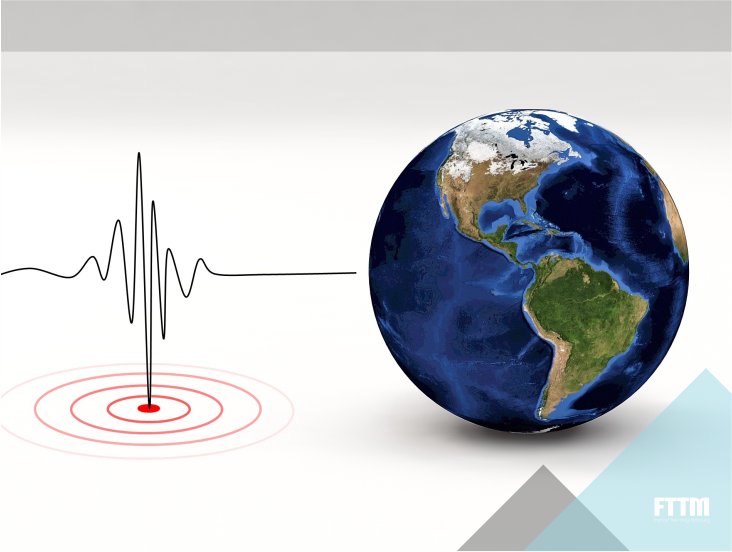Studi seismik anisotropi untuk identifikasi keberadaan hidrokarbon dari data seismik antar sumur
Head of Team : Prof. Awali Priyono
Team Members : Dr. Wahyu Triyoso
Hydrocarbon detection by studying anisotropy parameter integrated with reservoir characterization was done using a set of crosswell seismic, well log and surface seismic data. We employed non- linear tomographic inversion technique to invert the traveltimes picked from P-, SH-and SV-waves. Anisotropy parameter were estimated by Shear Wave Splitting method of SH – and SV- waves. Poisson’s ratio is calculated based on VP and VS. A crossplot of VP/VS – Poisson’s ratio was used to predict the hydrocarbon phase on the observation target. And a 3-D crossplot was used to locate the depth of the reservoir layers containing hydrocarbon. We validated the gas case reservoirs with well data. In our study, the sand reservoirs with gas case on the crossplot of VP/VS – Poisson’s ratio is correlated to the anisotropy value. We conclude that anisotropy can be used as attribute to characterize hydrocarbon reservoir.
Data and Method
The data used in this study is a set of croswell seismic data recorded in 2011. The crosswell seismic recording employed a 3-C receiver array and Z -track tool as borehole source producing P- and S-wavefields with the source sweep frequency was defined at 30 – 200 Hz. Each component recorded P-and S-waves, including the converted waves. One profile of crosswell data involved two boreholes; one borehole was assigned as source-well and another borhole was assigned as receiver-well.
We employed non-linear tomographic inversion technique to invert the traveltimes picked from P-,SH-and SV-waves (Pratt and Chapman, 1992; Taillandier et al., 2011). Shortest Path Raytracing (SPR) method was used in raypath calculation based on Moser (1991) and modified by Zhang dan Tokzös (1998). Anisotropy parameter were estimated by Shear Wave Splitting method of SH – and SV – waves Zhang et al., 2007) and analogy with Thomsen (2002). Poisson’s ratio is calculated based on VP and VS. A crossplot of VP/VS – Poisson’s ratio was used to predict the hydrocarbon phase on the observation target. Also, a 3-D crossplot was used to locate the depth of the reservoir layers containing hydrocarbon. We validated the gas case reservoirs with well data.
Result and Discussion
Results of the P -, SH- and SV tomographic inversion of the real data are presented in oneway – depth interval velocities. We overlaid the velocities on top of the appropriate crosswell seismic images to verify the tomographic inversion results (see Figure 1). Result indicates that tomographic inversion images coincide with the seiemic image.

Figure 1. Results of tomographic inversion of the real data, presented in oneway-depth interval velocities. (a) P -wave, (b) SH- wave and (c) SV-wave. Velocities overlay on top of the appropriate crosswell seismic images.
Figure 2a shows the anomaly of anisotropy an the depth of 13090 m and 1820 m. This anomaly is coincide with te Poission ratio anomaly (Figure 2b) as hidrocarbon indication.
We verified that the anisotropy anomaly consistently indicated the gas case layers. We also validated the gas case layers with the petrophysical data.

Figure 2. (a) Anisotropy section for the analysis of hydrocarbon presence. (b) Poisson’s ratio section for the analysis of hydrocarbon presence.
Conclusions
The tomography algorithm used in this inversion is robust. The tomography results are consistently matched with the appropriate crosswell seismic images. The anomaly on anisotropy, VP/VS and Poisson’s ratio section is supporting each other to indicate the presence of hydrocarbon. From the crossplot of VP/VS – Poisson’s ratio, the hydrocarbon type is gas. We conclude that anisotropy can be used as attribute to characterize hydrocarbon reservoir. The studied anisotropy is correlated to reservoir containing hydrocarbon, in this case are gas sand.
References
- Pratt, R. G. and Chapman, C. H. (1992): Traveltime tomography in anisotropic media-II. Application, Geophysics Journal International, 109, 20-37.
- Taillandier, C., Deladerrriere, N., Therond, A., and Le Meur, D. (2011): First arrival traveltime tomography – when simpler is better, 73rd EAGE Conference & Exhibition incorporating SPE EUROPEC 2011, Vienna, Austria.
- Moser, T. J. (1991): Shortest path calculation of seismic ray, Geophysics, 56, 59-67.
- Zhang, H., Liu, Y., Thurber, C., and Roecker, S. (2007): Three-dimensional shear-wave splitting tomography in the Parkfield, California region, Geophysical Research Letters, 34.
- Thomsen, L. (2002): Understanding seismic anisotropy in exploration and exploitation: SEG/EAGE Distinguished Instructor Series, SEG.

